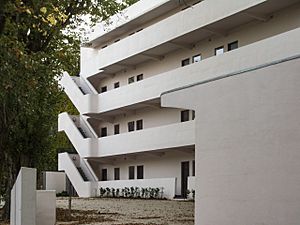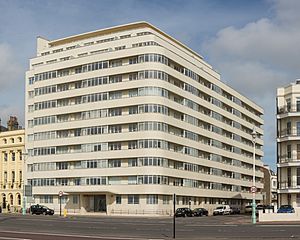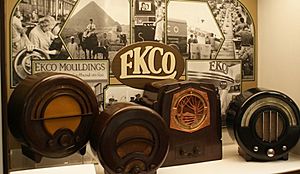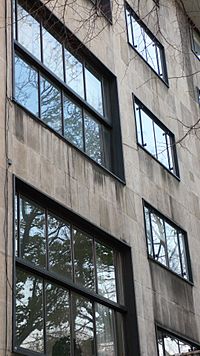Wells Coates facts for kids
Quick facts for kids
Wells Coates
|
|
|---|---|
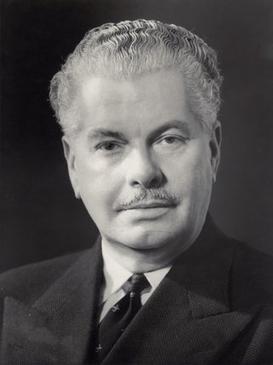 |
|
| Born |
Wells Wintemute Coates
December 17, 1895 Tokyo, Japan
|
| Died | June 17, 1958 (aged 62) Vancouver, British Columbia, Canada
|
| Nationality | British |
| Alma mater | University of British Columbia, East London College |
| Occupation | Architect |
Wells Wintemute Coates (December 17, 1895 – June 17, 1958) was a talented architect, designer, and writer. He was a Canadian who spent most of his life working in England. He is most famous for his work there, especially the modern apartment building called the Isokon building in Hampstead, London.
Contents
Early Life and Inspirations
Wells Coates was born in Tokyo, Japan, on December 17, 1895. He was the oldest of six children. His parents, Sarah Agnes Wintemute Coates and Harper Havelock Coates, were missionaries.
Wells Coates was inspired to become an architect by his mother. She had studied architecture herself and even designed one of the first missionary schools in Japan.
Coates grew up in the Far East and traveled around the world with his father in 1913. He served in World War I, first as a gunner and then as a pilot. After the war, he studied at the University of British Columbia and later engineering in London. He started his own design company in 1928.
His childhood experiences in Japan greatly influenced his unique style in architecture. This style fit perfectly with the Modernist Movement, which was popular in Europe at the time. He became a founder of the Modern Architectural Research Group (MARS), a British group that promoted modern design.
Between 1932 and 1936, Coates worked with English architect David Pleydell-Bouverie. Together, they designed the Sunspan House for a famous exhibition in London in 1934.
Designing Modern Buildings
Wells Coates believed in the idea that buildings should be "machines for living." This means they should be very practical and efficient, just like a well-designed machine. His most famous building, the Isokon building (also known as Lawn Road Flats), completed in 1934, showed this idea perfectly.
The Isokon building was designed for simple living. Its clean, striking look made novelist Agatha Christie, who lived there, compare it to an ocean liner. The building was created by Jack and Molly Pritchard, who wanted to build a place for thinkers and artists to live together. It became a safe place for people escaping problems in Europe and hosted many famous people, including Agatha Christie and other important designers like Walter Gropius.
The Isokon building was ahead of its time. It was not fully appreciated at first, but by the 2000s, it was recognized as one of England's most important modern buildings. It was fully restored in 2004.
Other Creative Works
Wells Coates loved to introduce new ideas in his work. One of his clever ideas was the '3-2' architectural plan. This meant that two rooms on one side of a building could be as tall as three rooms on the other side, creating interesting living spaces. He also designed the simple "D-handle" for doors, which is still used today.
In 1930, he designed a studio for the British Broadcasting Corporation. He also created a special microphone stand that could be moved easily around the studio while staying perfectly balanced. This design became a standard piece of equipment at the BBC. Coates also designed the unique round cabinets for EKCO radios in the 1930s. His Model AD-65 radio design was so important that it is now in the V&A Museum's permanent collection.
The 1930s were his busiest years. After the Isokon, he designed Embassy Court in Brighton (1935) and 10 Palace Gate, Kensington (1939). These were the only apartment buildings he designed, though he also created several private homes.
During World War II, he worked for the Royal Air Force again, helping to develop fighter aircraft. For this work, he received an award called the OBE. After the war, he helped with Britain's housing efforts by suggesting a plan for modular homes, which he called Room Unit Production.
In 1949-50, he designed the Telekinema building for the Festival of Britain. This cinema could show both films (including the first 3D films) and large-screen television. It was very popular and later became the National Film Theatre.
He also designed a unique boat called the Wingsail. It had a special rigid sail and a catamaran hull, which were very advanced for its time.
Coates also worked on city planning projects. He made plans for clearing slums in Britain and for a new town in Canada called Iroquois, Ontario. He also worked on a project to redevelop Toronto Island and a plan for Vancouver called Project 58.
Later Years in Canada
Coates moved back to Canada in the early 1950s and settled there in 1957. He taught at Harvard University for two years but then returned to Vancouver. His last project was to design a monorail rapid transit system for Vancouver, called the Monospan Twin-Ride System. This idea was also ahead of its time and was not built then, but it later inspired Vancouver's SkyTrain system.
Wells Coates died from a heart attack in Vancouver on June 17, 1958, when he was 63 years old. He was married to Marion Grove and had one child, Laura. His grandson is Matt Black, a musician from the group Coldcut.
Images for kids
See also
 In Spanish: Wells Coates para niños
In Spanish: Wells Coates para niños


